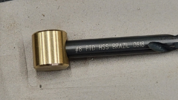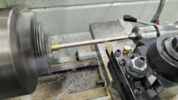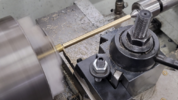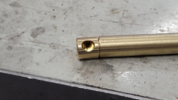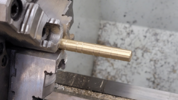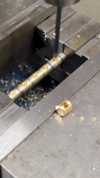You are using an out of date browser. It may not display this or other websites correctly.
You should upgrade or use an alternative browser.
You should upgrade or use an alternative browser.
The means of production has been seized
- Thread starter STRider
- Start date
mello dude
Half genius, half dumazz whackjob foole
Is it black or silver? Can't tell from the pics.
thxz
Last edited:
Ha, ha, typical. I have a few old school mics, and as I get older it seems that somehow the markings are getting smaller over time and harder to read. So I have one digital mic, and I always remove the battery after each use and place it in the case.Plus, the digital micrometer I did bring, had a dead battery!
STRider
Site Supporter
Found in the Fleabag purchase history. Part number 53180-MEJ-006
What the Gargler says when you ask: "what motorcycle models does 53180-mej-006 fit"
"The part number 53180-MEJ-006, a left-hand handle lever, fits several Honda motorcycle models, including the CBR1000RR (2004-2007), CB1100 (2013-2017), VFR1200 (2010-2014), and VFR800 Interceptor (2014-2015). It also fits the VFR800 (2014-2015) and the CB1300 Super Bold'or ABS (2010). Specifically, it's used for the clutch master cylinder on the 2004-2007 CBR1000RR."
What the Gargler says when you ask: "what motorcycle models does 53180-mej-006 fit"
"The part number 53180-MEJ-006, a left-hand handle lever, fits several Honda motorcycle models, including the CBR1000RR (2004-2007), CB1100 (2013-2017), VFR1200 (2010-2014), and VFR800 Interceptor (2014-2015). It also fits the VFR800 (2014-2015) and the CB1300 Super Bold'or ABS (2010). Specifically, it's used for the clutch master cylinder on the 2004-2007 CBR1000RR."
Ha, ha, typical. I have a few old school mics, and as I get older it seems that somehow the markings are getting smaller over time and harder to read. So I have one digital mic, and I always remove the battery after each use and place it in the case.
I do the same with my calipers, for the same reason.
I cross referenced this with the same part of the VALKYRIE which I have extensive files from 10 years of ownership and riding... theSo there's this part on our STs.
It's a small part.
Downright tiny part.
All of about 10x10mm.
Made of brass.
It wears and affects the rideability of our bikes.
And it costs $10 USD!
What this exotic part you ask?
The bushing in your lever that actuates the clutch.
,
A while back I decided $10 couldn't be right. For that little part? And apparently the retailers felt the same and that part that was $9.99 a few months ago is now $13.83!!
Enough. I have access to a milkcrate full of brass rod and a high school metal shop full of machine tools (remember that).
I'm going to make my own. Let's call it a "personal on-shoring" of industrial production.
First thing was to get the measurements.
The Mitutoyos say: 9.93mm diameter, 10.01mm tall and the hole...
Well calipers aren't the best way to measure a small hole. Gauge pins are. But... high school metal shop. Such exotic items wouldn't last a school day without getting lost, bent, welded onto some other scrap of metal. Only kidding, but no, there are no gauge pins to be found.
However, I do work to keep the teacher's drill index fully stocked. A No. 8 twist drill was a perfect fit. 0.199" Better than a gauge pin. It can tell me the size and make more of those holes in my brass rod.
First step decide on a length to turn. I'm not making just one. I'm making several in batch fabrication mode. I chucked enough to make what turns out to be nine bushings. So, 10mm per part, plus 5mm for kerf. So about 150mm or 6" of stock and another 2" to chuck it.
I spot drill the end first and then chuck it with a live center during the turning operations.
Note the condition of the jaws on the chuck. High School Metal Shop
Parting off is always satisfying.
I didn't have the abrasives for a nicer finish than this. High School Metal Shop But it will burnish during use pretty quickly. Notice the chamfer on the edge of the hole in the OEM part.
I was so eager to part off the rod once I reached the target O.D. that I forgot about some useful operations best done before parting on the lathe. That was marking those 10 and 5mm sections in the metal itself using the DRO (digital readout - the electronic display of the position of cross slide).
Back onto the lathe.
Next it was off to the mill where I clamped in some V-blocks, found the center using and edge finder and the DRO and spot drilled where the holes would be placed.
Followed by using that same No. 8 drill I used to measure the hole in the OEM part to make the holes in my rod. 0.330" to be exact.
The floor of the hole in the OEM is square - they either plunged a square-ended mill to make the hole, or drilled and finished with a mill. Regardless, at the moment the floor of my holes have a 125° to 135° angle. I'm not sure if I want or need to bother with making it square. We don't have 0.200" endmills. Nor do we have 5mm endmills. 'Murica damn it!
That's where I left it Tuesday. Back to the shop tomorrow (Thursday) to chamfer the holes and part them off. The finish of the ends is irrelevant. As is nearly the length. I want full engagement with the bore in the lever; it just must not protrude to the point where it interferes with its movement into the body of the master cylinder.
Stay tuned...
Clutch lever bushing
The Honda part Number 2285-MBO-006 is $10
The Suzuki part number 59892-08A00 is $3 and exactly the same part.
*** I did once change it on the Valk so I know that it is a FIT.
*** I did once change it on the Valk so I know that it is a FIT.
mello dude
Half genius, half dumazz whackjob foole
Andrew Shadow
Site Supporter
Just an F.Y.I. for those with digital measuring instruments. It is important to use the correct battery to obtain longer battery life. As an example, if the specified battery is an SR44 you will often see the LR44 battery listed as a direct substitute. It is physically the same size but they are not the same. The SR44 is a silver oxide battery. The LR44 is an alkaline battery. Silver oxide batteries most commonly are specified for measuring instruments because they provide a more stable voltage output for longer than alkaline batteries do, and alkaline batteries will deplete sooner.
Another issue is that when a digital measuring instrument is turned off only the display goes off. The electronics stay powered and continue to consume a minute amount of power. If it is used infrequently, or if it will be a long time before it is used again, it is a good idea to remove the battery to conserve it.
Another issue is that when a digital measuring instrument is turned off only the display goes off. The electronics stay powered and continue to consume a minute amount of power. If it is used infrequently, or if it will be a long time before it is used again, it is a good idea to remove the battery to conserve it.
- Joined
- May 27, 2021
- Messages
- 1,163
- Age
- 64
- Location
- Coquitlam British Columbia Canada
- Bike
- 2009 ST1300
I've got some good millwright and machinist friends who only use digital vernier calipers, for decades. I don't trust them and if I had one, cheap as I am, I'd probably give it away to someone I didn't like, but then again, I still only believe what my sling psychrometer and pitot tube / slant gauge says.
Andrew Shadow
Site Supporter
Why not? Assuming proper use and care, and not being abused, they have been proven reliable over decades of use.I don't trust them ......
ST Gui
240Robert
This. It's meant to be sacrificed. You did something I couldn't even if I had the kit. Knowing that I made a part that can replace store bought would be huge. Developing a skill and honing a skill while having a good time could be the next best thing to riding. Thanks for sharing.but in the end it's a bushing guys
- Joined
- May 27, 2021
- Messages
- 1,163
- Age
- 64
- Location
- Coquitlam British Columbia Canada
- Bike
- 2009 ST1300
What's the saying, I'm from Arkansa, [edited]
Last edited:
- Joined
- May 27, 2021
- Messages
- 1,163
- Age
- 64
- Location
- Coquitlam British Columbia Canada
- Bike
- 2009 ST1300
[edited] will have to research the digital a little more,
Last edited:
ST Gui
240Robert
I think I'll order one as well. I had a third-party adjustable lever that made life easier when the arthritis acted up. But If I adjusted it to bring the lever too close the grip when squeeze the clutch would disengage but switch wouldn't work and IIRC I couldn't start the bike while moving and the clutch in. Not that it's an everyday thing but if the bike stalls in traffic you would have to shift to Neutral then start then go. It could get embarrassing at best.
I don't know if this applies to the lever STR has but it might be worth checking out. But even dialing in the lever a couple of 'clicks' it worked and was a game changer for me.
STRider
Site Supporter
Yes, this is mentioned with the Mitutoyo calipers. Haven't located a trustworthy source of SR44 batteries yet, but the original which came with the calipers is still going strong.Just an F.Y.I. for those with digital measuring instruments. It is important to use the correct battery to obtain longer battery life. As an example, if the specified battery is an SR44 you will often see the LR44 battery listed as a direct substitute. It is physically the same size but they are not the same. The SR44 is a silver oxide battery. The LR44 is an alkaline battery. Silver oxide batteries most commonly are specified for measuring instruments because they provide a more stable voltage output for longer than alkaline batteries do, and alkaline batteries will deplete sooner.
Another issue is that when a digital measuring instrument is turned off only the display goes off. The electronics stay powered and continue to consume a minute amount of power. If it is used infrequently, or if it will be a long time before it is used again, it is a good idea to remove the battery to conserve it.
Quality digital calipers are a real step forward. I particularly like being able to use an incremental mode to zero the calipers at any position and measure referenced to that. For instance, I measure the diameter of the OEM bushing at 9.93mm, but if I zero on that, my target dimension for the part I'm turning now becomes zero and I see exactly how much material I need to remove to achieve target dimension on each pass. Not impossible, but much harder to do on a dial or vernier caliper.I've got some good millwright and machinist friends who only use digital vernier calipers, for decades. I don't trust them and if I had one, cheap as I am, I'd probably give it away to someone I didn't like, but then again, I still only believe what my sling psychrometer and pitot tube / slant gauge says.
I bought some cheap and nasty Harbor Freight or the like digital calipers and, yes, they're worth exactly what you pay for them. The Mitutoyo's aren't quite worth their weight in gold, but close.
Was this the post and video you were referring to @Chris09 ?What's the saying, I'm from Arkansa, and... [not to distract to much further from this awemsome post; same guy that brought the realization that moderate application of the rear compared to the forward MCs produced unexpected twice fold SMC travel, story to revisit on another day I suppose. Great post
SMC in action! | ST1300-Brakes
Among the things I didn't think would be an issue on my pristine 2012 ST1300A with 3,600 miles on it when I bought it in the summer of 2020 would be a non-functional SMC the likes of which seemed limited to those bikes with more years and certainly more miles than my new-to-me bike had...
- Joined
- May 27, 2021
- Messages
- 1,163
- Age
- 64
- Location
- Coquitlam British Columbia Canada
- Bike
- 2009 ST1300
Yes, that's the post, and in my reference [post 53] I got wrote it backwards again so I'll delete that one. I'm becoming a reliable source of misinformation.
Share:



